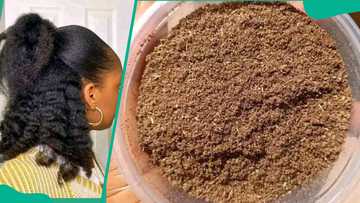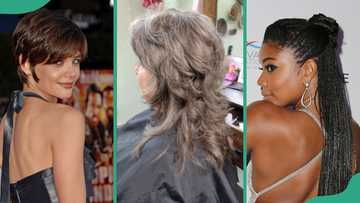African threading for hair growth: benefits and disadvantages of these styles
There are several hair care techniques for natural hair, but African threading is fast gaining popularity. The method has been around for a long time, and it entails using a thread to wrap sections of hair, creating different designs that protect hair from various damages. With many people needing ways to protect their natural hair, African threading has emerged as one of the most preferred options. The hair care technique can enhance growth potential by retaining length and minimising breakage.
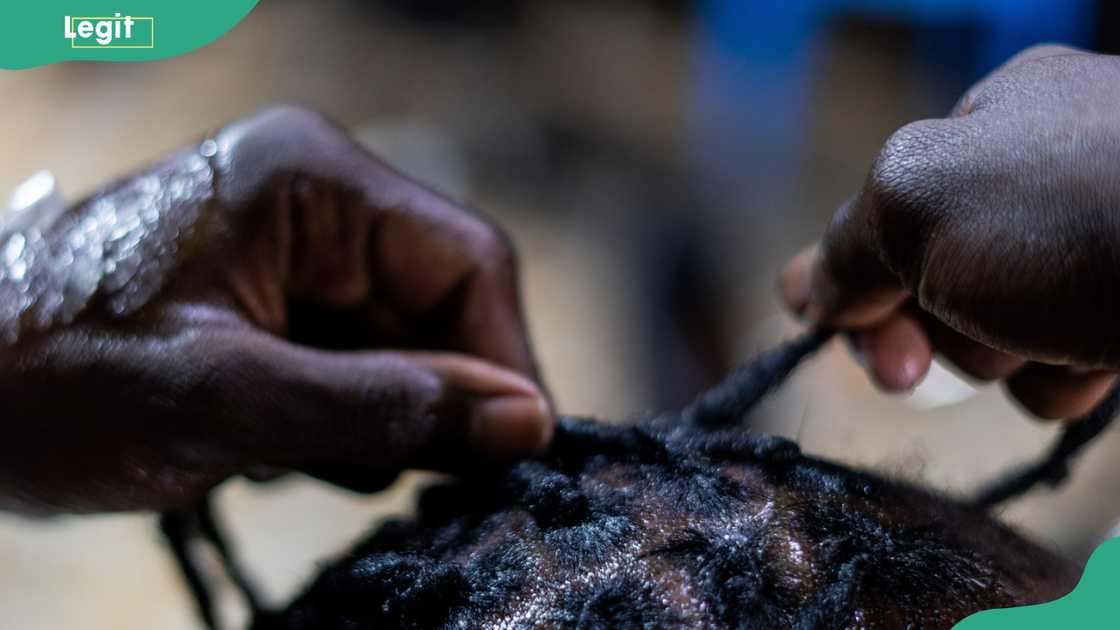
Source: Getty Images
TABLE OF CONTENTS
- Does African threading promote hair growth?
- How to do African threading on natural hair
- Benefits of African threading
- What are the disadvantages of threading?
- Can threading increase hair growth?
- How long can you leave in African threading?
- Is threading hair effective?
- What is the purpose of African hair threading?
- What are the most popular African threading styles?
Hair gets the most attention, as many believe neat hair significantly contributes to one's beauty. African threading is one of the several innovative and resourceful natural hair care techniques today. While many view it as a style, it is a way of protecting, managing, and growing natural hair. It is a simple technique with several styles lasting between days and weeks, depending on the style and protection level desired.
Does African threading promote hair growth?
African threading is an ancient hair care technique for styling natural hair by wrapping it around a thread. In ancient times, it was just another hairstyle, but with the realisation of its hair growth potential, today, it is a hair care technique that has drawn many people’s attention.
Unlike in the past, when only a few threading styles existed, you can thread your natural hair in various designs nowadays. For example, you can opt for simple styles like straight back or complex styles like Ghanaians. Other popular African threading styles include Nubian, Patewo, Shuku, and Corkscrew.
How to do African threading on natural hair
African threading is a simple technique; if you have never attempted it, learning how to execute it is simple. Since it is not complex, you can either do it at home by following tips or seeking the assistance of a professional salonist. The guide below illustrates easy tips for threading your natural hair.
- Prepare your hair. Wash and condition your hair to ensure it is clean. Then, moisturise it using a leave-in conditioner or a preferred hair oil to make it soft and easy to work with.
- Divide your hair into sections. Using a comb, partition your hair into small sections. The size of a section determines how thick or thin each threaded strand will become.
- Wrap each section using a thread. Begin at the bottom of each section and tightly wrap a thread around it to the top. Although it is recommended to wrap it tightly, exercise caution as too tight can damage your scalp. Wrap every section created to the top.
- Secure the end. After wrapping each section to the top, secure the end by tightly tying it using a thread. This ensures that it does not get loose and releases the threads.
- Style as desired. When all sections are appropriately threaded, you can leave your hair as it is or style it. Styling makes it more appealing by incorporating different shapes and designs.
Benefits of African threading
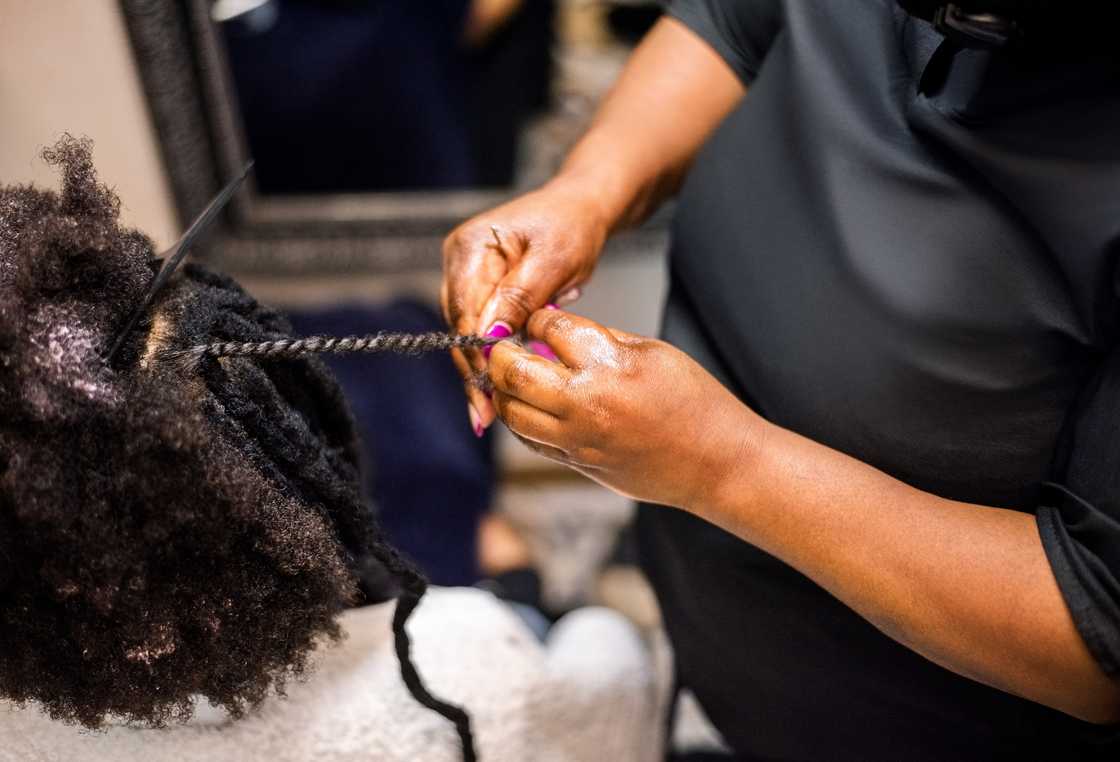
Source: Getty Images
Why should you opt for African threading? The style is simple yet has several benefits. Below are some of the things you can gain from the hairstyle.
- Threading minimises breakage. – It protects hair from external elements like harsh weather, which can lead to breakage and split ends.
- Stretch hair – Threading helps stretch tight curls or kinks without heat. This reduces tangles, which are a common cause of breakage.
- Low manipulation – Because hair is tucked away and doesn’t require daily styling, it is less prone to damage.
- Less tangling – If hair tangling bothers you, African threading can be a solution. The style stretches your hair and keeps it from shrinking or twisting.
- Less heat – Heat damages hair, and threading is one way of minimising heat damage. For many, it is an alternative to blow-drying before flat ironing.
- Moisture retention – Conditioning before hair threading ensures that your hair remains moisturised for the period you wear the style. Moisture prevents unnecessary hair breakage.
What are the disadvantages of threading?
African threading is a favourite style for many people. However, it is not without its downsides that you should know to make an informed decision about whether to have it. Below are some of the disadvantages of the hairstyle.
- Tension of the scalp – Tightly wrapped thread around the hair can lead to scalp tension, causing uncomfortable pain. Sometimes, a tightly wrapped thread may cause headaches or hair breakage. If the extension of the scalp prolongs, it may lead to a condition known as traction alopecia.
- Hair dryness – When threading is left on the hair for a long time, it can cause dryness, as the thread absorbs all moisture from the hair. Dry hair is weak and can easily break. Therefore, if you intend to leave the threading on the hair for a long time, ensure that you moisturise your hair to prevent breakage.
- It is a time-consuming exercise – Simple threading takes little time, but if you have long hair and want an intricate design, it takes significant time. Therefore, if you want something good, you must be patient and wait.
- Challenge in washing the hair – It is not easy to wash threaded hair, and if you need to wash your hair frequently, African threading may not be the best hairstyle. Since the hair is tightly wrapped, you cannot clean it thoroughly or remove all the dirt. Unclean hair may cause scalp irritation.
- Hair tangles after removal – Threaded hair can tangle if left for a long time or if the removal process is hurried. When tangled, hair can easily break during detangling. Therefore, you should not leave your thread hair for a long time or exercise caution when detangling to avoid breakage.
Can threading increase hair growth?
African threading is widely believed to increase hair growth, but in reality, it does not directly increase hair growth. The hair growth rate depends on a person’s genes and state of health; therefore, African threading does not play a part.
However, African threading is helpful for hair length retention by reducing manipulation and breakage. The hairstyle also stretches natural hair without heat, managing shrinkage and making hair easy to style.
How long can you leave in African threading?
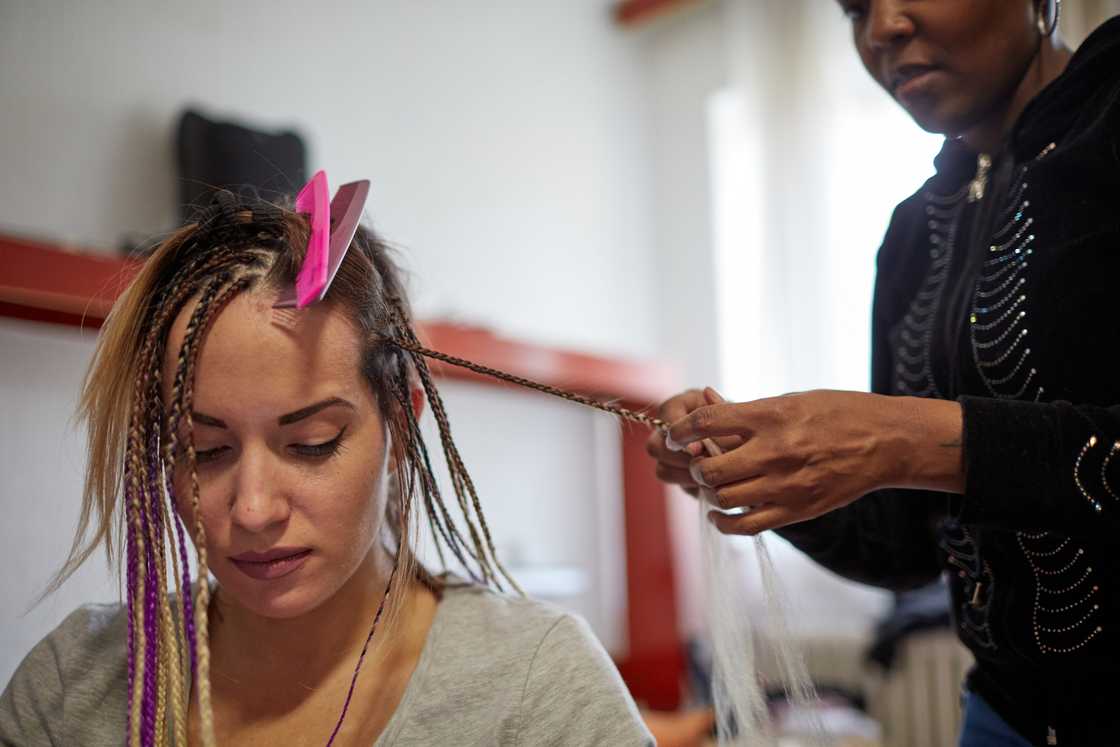
Source: Getty Images
You can leave in African threading for at least two or four weeks. The leave-in period is also determined by hair type and threading design. Even though your hair might look good after four weeks, it is not advisable to leave it any longer as long periods reduce the need for manipulation. An extended leave-in period may also lead to dirt and oil build-up, tangling, and breakage.
Is threading hair effective?
Yes, threading hair is an effective protective style for those with natural or textured hair. Its benefits include length retention, stretching hair, and scalp health.
What is the purpose of African hair threading?
African threading is widely considered a protective hairstyle. Its primary purpose is to promote healthy hair growth and prevent breakage. With its varied designs, many opt for it to express creativity and personal identity using intricate patterns. In some communities, African threading symbolises heritage, pride, and celebration of African identity.
What are the most popular African threading styles?
African threading has a wide range of protective and stylish patterns. The most popular hairstyles include threaded pigtails, crowns, box threading, zigzag threading, and Ghanaian threading.
For many, African threading is an excellent option for hair growth. The hairstyle has several benefits, including length retention, minimal breakage, and healthy natural hair. Interestingly, you can style it to achieve a personalised appearance. It is one of the best ways to care for your natural hair.
Legit.ng recently published weaving hairstyles for natural hair. Weaving is one of the many ways of protecting natural hair. With several styles available, you can choose a suitable style for your hair length, volume, and growth density. Moreover, they are simple and can be easily created at home.
If you are worried about hair damage, you can opt for weaving without braids. You can choose from several styles, which are simple and less costly to maintain. Check out the article for compilation of weaving hairstyles for natural hair protection.
Source: Legit.ng


